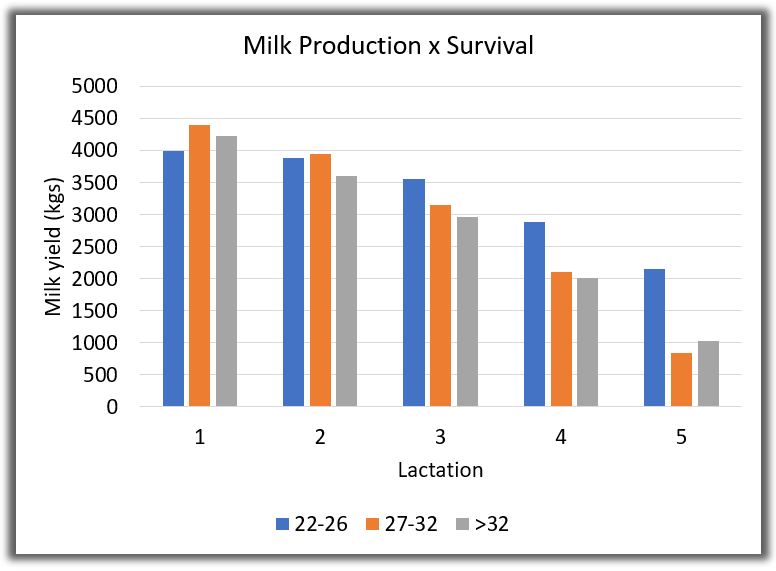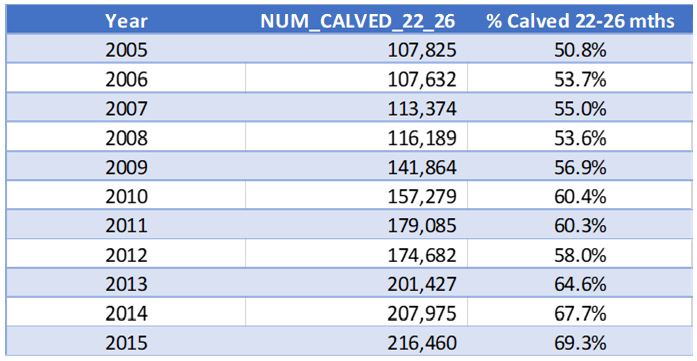When it comes to calving in dairy heifers for the first time, opinions differ as to what is the optimum age to calve them. Teagasc recommends calving heifers at 22-26 months of age as a key performance indicatior (KPI) to increase on-farm profit. Last year ICBF’s Susan Moriarty carried out a study on the optimum age at first calving. The following were her findings:
Objective
The purpose of this research was to access the association between age at first calving (AFC) on milk production and survival in dairy heifers
Statistics were evaluated on 4 categories of Age First Calving (AFC):
- <22 months
- 22-26 months
- 27-32 months
- >32 months
Methodology
Statistical Analysis System (SAS) software was used to select and remove undesired data. Year of calving selected was 2014 to analyse data on 5 full lactations. All animals below 20 months were removed as these animals would not purposely be put in calf at that age. All animals over 40 months of age were removed as this was the cut-off point chosen. Over 90% of the herd had to calve between January to June. Spring calving herds were selected as these are the target herds that we want to promote and encourage calving at the optimum age of 22-26 months. 305d milk figures were used to compare like with like milk production. Only dairy animals with consecutive milk recording records were used.
Graph 1: Distribution of AFC

Graph 1 displays the percentage of animals that calved for each AFC (month). It is positive that nearly 20% are calving at 24 months. However, there is large scope for improvement. The number of calving’s dip off quite suddenly after 25 months. It continues to fall until 30 months where it begins to rise until 36 months. This indicates the tradition of calving heifers at three years of age is still practiced on some farms. These are the herds that need to be targeted to promote the benefits of calving at two years of age. The total number of animals included in the study was 160,334. As there were only 950 animals in the under 22 months category, these were not compared nor used in the research.
Graph 2: Milk Production

Graph 2 displays the milk production for parity 1, 3 and 5 for 22-26 months, 27-32 months and over 32 months. The milk production graph highlights the category 27-32 months is surpassing the other two age categories for parity 1,3 and 5. This can be related to the fact they are older when first calved, therefore carrying more weight, thus having the ability to produce more milk. In contrast, the over 32 months do not surpass the 27-32 age category for milk production. Older heifers can develop fatty udders before they eventually calve down and this will impact their milk production for the rest of their lives resulting in suppressed yields.
Also, why was she late calving in the first place? Some herds, that can’t get a heifer in-calf to calve down at 2 years old, will give her another opportunity six or twelve months later, however, there may be an underlying management and/or health/disease issue that means she is under pressure, hard to conceive and also not performing at her maximum.
Graph 3: National Survival Statistics

Graph 3 above displays the percentage of animals surviving to parity 2, 3, 4, 5 and 6 for the three age categories. It is clear the optimum age category of 22-26 months, have a higher percentage of animals surviving to each parity. For example, 30% of animals from the optimum age category survive to parity 6, in comparison to 11% of the 27-32 month category. The graph also highlights the significant drop and lower number of animals surviving in the two older age categories 27-32 and over 32 months.
Graph 4: Production differences between AFC 22-26M, 27-32M and 32M+

When survival is incorporated into the milk production, we now see a different outcome for which age category produces more. Graph 4 highlights the optimal age 22-26 in parity 1 does not produce as much versus the other two categories. However, by the end of parity 2, the optimal age group have surpassed the older 32 months group. By the end of parity 3, they have surpassed the 27-32 age group and they continue to surpass both older age categories significantly in parity 4 and 5. Therefore, it can be seen that the optimal 22-26 month first lactation milk production was lower, but lifetime milk yield was significantly increased.
As a comparison, we focused on parity 1 of the optimal age group and the older 32 months. At the end of parity 1, the older 32-month category produced 240kg additional milk, 3kg additional fat and 6kg additional protein then our optimal group. However, at the end of parity 4, the optimal 22-26 month category produced 862kg additional milk, 38kg additional fat and 33kg additional protein then the older 32-month group. An average milk price of 30.5 c/l was used and applied to get the net value of production. €0.04 milk yield penalty, €3.637 per kg fat bonus and €6.183 per kg protein bonus were applied to get the total net outcome for each group. The difference in the net outcome between the optimal 22-26 month and older 32 month was €307. If this was to occur in a 100-cow herd, there would be a loss of €30,700 by not calving heifers between 22-26 months.

The above table displays the number of calving’s for 22-26 months over a 10-year period. It is positive to see there has been an increase in the percentage calved at 22-26mths but there is still a large area for improvement.
Conclusion
The research highlights the importance of AFC for survival of heifers and calving at optimal 22-26 months for increased lifetime yield and increased profitability. A lower age at first calving is associated with increased survivability and increased lifetime yield. First lactation milk production was lower among younger heifers, but lifetime daily milk yield was significantly increased. Minimising the number of replacements to rear, as well as only identifying the most reproductively efficient heifers is essential to avoid unnecessary economic losses. Sustainability is also improved as a lower age at first calving results in cows lasting longer in the herd, therefore reducing the replacement rate. Also, calving heifers earlier prevents additional unwanted methane that older calving heifers produce.
For more information, click here to view slides on this study
